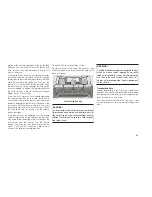
competent mechanic inspect the complete ex-
haust system and adjacent body areas for broken,
damaged, deteriorated, or mispositioned parts.
Open seams or loose connections could permit
exhaust fumes to seep into the passenger com-
partment. In addition, inspect the exhaust system
each time the vehicle is raised for lubrication or oil
change. Replace as required.
Safety Checks You Should Make
Inside The Vehicle
Seat Belts
Inspect the seat belt system periodically, check-
ing for cuts, frays, and loose parts. Damaged
parts must be replaced immediately. Do not dis-
assemble or modify the system.
Front seat belt assemblies must be replaced after
a collision. Rear seat belt assemblies must be
replaced after a collision if they have been dam-
aged (i.e., bent retractor, torn webbing, etc.). If
there is any question regarding belt or retractor
condition, replace the seat belt.
Airbag Warning Light
The light should come on and remain on for six to
eight seconds as a bulb check when the ignition
switch is first turned ON. If the light is not lit during
starting, see your authorized dealer. If the light
stays on, flickers, or comes on while driving, have
the system checked by an authorized dealer.
Defroster
Check operation by selecting the defrost mode
and place the blower control on high speed. You
should be able to feel the air directed against the
windshield. See your authorized dealer for service
if your defroster is inoperable.
Periodic Safety Checks You Should
Make Outside The Vehicle
Tires
Examine tires for excessive tread wear and un-
even wear patterns. Check for stones, nails,
glass, or other objects lodged in the tread. In-
spect the tread and sidewall for cuts and cracks.
Check the wheel nuts for tightness. Check the
tires (including spare) for proper pressure.
Lights
Have someone observe the operation of exterior
lights while you work the controls. Check turn
signal and high beam indicator lights on the
instrument panel.
Door Latches
Check for positive closing, latching, and locking.
Fluid Leaks
Check area under vehicle after overnight parking
for fuel, engine coolant, oil, or other fluid leaks.
Also, if gasoline fumes are detected or if fuel,
power steering fluid, or brake fluid leaks are
suspected, the cause should be located and
corrected immediately.
41
Summary of Contents for Cherokee 2009
Page 1: ......
Page 2: ......
Page 3: ......
Page 5: ...2...
Page 9: ...6...
Page 11: ...8...
Page 15: ......
Page 45: ...42...
Page 50: ...Rear Window Defroster If Equipped 89 ROOF LUGGAGE RACK IF EQUIPPED 90 47...
Page 51: ......
Page 63: ...60...
Page 64: ...61...
Page 65: ...62...
Page 97: ...INSTRUMENT CLUSTER 94...
Page 106: ...Compass Variance Map 103...
Page 111: ...Compass Variance Map 108...
Page 116: ......
Page 120: ...117...
Page 123: ...Control Setting Suggestions for Various Weather Conditions 120...
Page 147: ......
Page 159: ......
Page 162: ......
Page 175: ...172...
Page 179: ......
Page 210: ...9 IF YOU NEED CONSUMER ASSISTANCE IF YOU NEED ASSISTANCE 208 207...
Page 212: ...209...
Page 213: ...210...
Page 214: ...10 INDEX 211...
















































